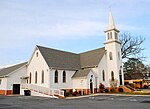Union Wesley Methodist Episcopal Church Complex

The Union Wesley Methodist Episcopal Church Complex is a historic church and summer camp meeting facility on Powell Farm Road near Clarksville, Delaware. The property was developed in the post-Civil War era as a summer religious camp for African Americans. It was established around 1873, with an open tabernacle structure for religious functions, surrounded by modest cottages. An 1890 one-room schoolhouse that was used in the education of African-American children was adapted as the camp's refectory in 1922, and in 1959 the Union Wesley Methodist Episcopal Church was built on the property. The school building in particular is notable as one of the best-preserved late 19th-century schools for African-Americans in the state.The complex was listed on the National Register of Historic Places in 2014.
Excerpt from the Wikipedia article Union Wesley Methodist Episcopal Church Complex (License: CC BY-SA 3.0, Authors, Images).Union Wesley Methodist Episcopal Church Complex
Powell Farm Road,
Geographical coordinates (GPS) Address Nearby Places Show on map
Geographical coordinates (GPS)
| Latitude | Longitude |
|---|---|
| N 38.545 ° | E -75.146944444444 ° |
Address
Powell Farm Road 32101
19945
Delaware, United States
Open on Google Maps






